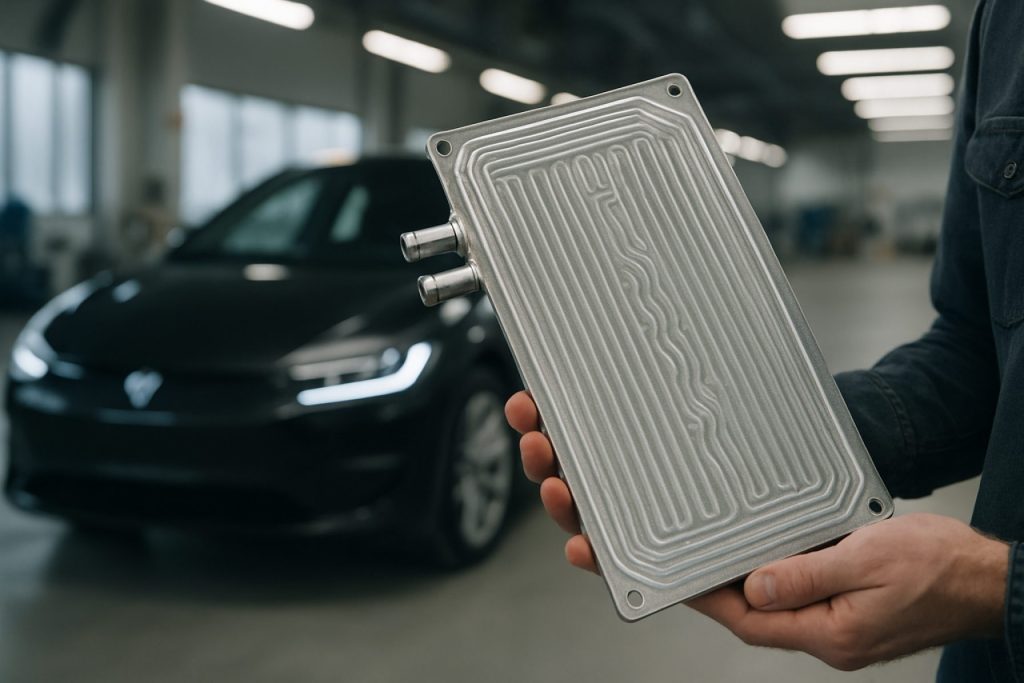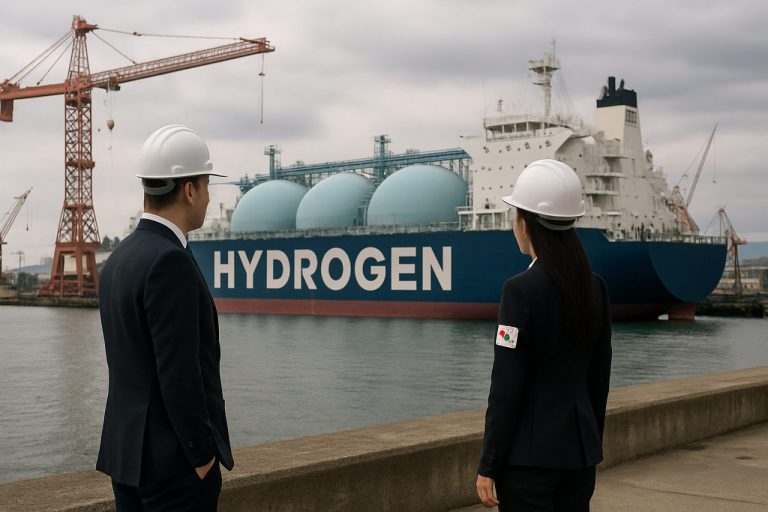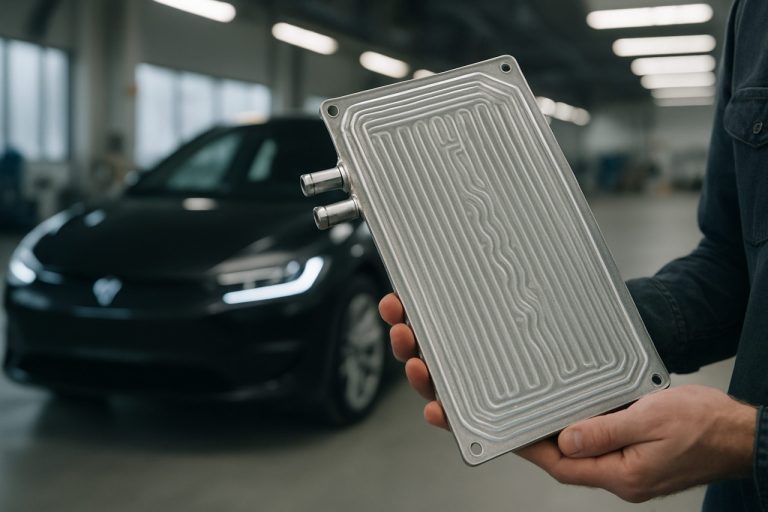
- EV battery cooling plates are crucial for managing heat, extending battery life, and ensuring safety in electric vehicles.
- As EV adoption rises, demand for advanced cooling technology is forecasted to push the global market to $3.2 billion by 2031, growing at 11.7% annually.
- Asia-Pacific—led by China—dominates production and innovation in battery cooling solutions, with North America rapidly expanding EV infrastructure.
- Modern cooling plates, especially rectangular types, deliver uniform thermal management for high-capacity batteries in BEVs and commercial EVs.
- Major companies like Valeo, Mahle, Dana, BorgWarner, and BYD are driving fierce competition and rapid technological advancements.
- Effective thermal management is essential for charging speed, range, reliability, and compliance with evolving safety standards in electric mobility.
Glossy electric cars zip along city streets, their silent acceleration hinting at an energy revolution humming beneath the surface. But behind every breakthrough in range and charging speed, an unsung hero is quietly reshaping the industry: the EV battery cooling plate.
Under the Hood: Engineering an Electric Evolution
Electric vehicles (EVs) have surged from futuristic novelties to mainstream necessities, with global adoption accelerating at full tilt. It’s a transformation powered not just by eco-conscious drivers, but by the relentless march of battery technology. As automakers compete to deliver vehicles with greater range and faster charging, high-capacity lithium-ion batteries have become the beating heart of every EV.
Yet when energy flows rapidly during charging or high-performance driving, batteries heat up—sometimes alarmingly so. Enter the battery cooling plate: a meticulously engineered component, often formed from aluminum or composite metals, that cradles battery cells and channels coolant in intricate patterns. These plates perform the unseen—yet vital—work of keeping temperatures in check, preserving battery life, and reducing fire risk.
Explosive Market Trajectory
Analysts forecast the global market for EV battery cooling plates to skyrocket at an annual pace of 11.7%, reaching a massive $3.2 billion by 2031. Asia-Pacific, a region pulsing with the production lines of BYD, NIO, Toyota, and Hyundai, dominates EV manufacturing and now leads the demand for advanced cooling technologies. China’s battery giants CATL and Panasonic are pushing innovation, while generous government subsidies electrify the competitive atmosphere.
North America is catching up fast, riding a wave of EV adoption and multi-billion-dollar investments in domestic battery production.
Why the “Plate” is So Critical
Not all EVs are wired alike. Battery Electric Vehicles (BEVs)—the pure electrics—pack larger batteries than their hybrid cousins. These hefty power packs generate substantial heat, especially as fast-charging stations sprout up worldwide and new battery chemistries push energy density higher. Cooling plates for BEVs have evolved into sophisticated designs, with rectangular plates providing broad, uniform coverage for family cars and commercial fleet vehicles alike.
The choice of plate type and how it integrates into the vehicle matters. Most automakers favor rectangular plates for their proven cooling performance and modular fit. Light vehicles, comprising the bulk of global EV output, demand cutting-edge solutions to keep up with rising expectations for safety, range, and reliability.
A Contest of Titans
Across production lines, industry titans—Valeo, Mahle, Dana, BorgWarner, and BYD—jostle for leadership. Each brings a unique focus to innovation, manufacturing techniques, and strategic alliances. Competition sharpens the edge, spurring research into lighter materials, more efficient coolant pathways, and smarter thermal management systems.
Original Equipment Manufacturers (OEMs), wielding scale and technical expertise, hold the market’s lion’s share, forging direct supplier partnerships to lock in new advances and secure their place in an electrified future.
Big Stakes, Bigger Opportunity
Underpinning the surge is an urgent imperative: control heat, extend battery life, and unleash the full promise of electric mobility. Efficient cooling is what enables vehicles to travel farther, charge faster, and operate more safely—features that consumers demand, and regulators increasingly require.
Strategists, investors, and engineers eye this evolving landscape as more than just a technical challenge; it’s a $3.2 billion opportunity shaping the next chapter in automotive history.
The Takeaway: The humble EV battery cooling plate may never grab headlines, but its impact is enormous. As global competition intensifies and new technologies emerge, these components form the unsung backbone of electric vehicle progress. For anyone betting on the future of mobility, understanding the science—and business—of keeping EV batteries cool is no longer optional; it’s essential.
Discover more about electric vehicles and cutting-edge automotive innovation at BYD and Panasonic.
The Hidden Tech Revolution Driving Every Electric Vehicle: Why Battery Cooling Plates Hold the Key to Range, Safety, and the $3.2 Billion EV Boom
Unveiling the Power & Potential of EV Battery Cooling Plates
The silent, seamless power behind every electric vehicle’s instant acceleration isn’t just cutting-edge battery cells or motors—it’s a sophisticated, rapidly evolving system of battery cooling plates. These quiet champions are not merely mechanical afterthoughts, but critical to unlocking efficiency, safety, and the fast-charging future consumers crave. Let’s dive into the vital facts, emerging trends, pressing questions, and actionable tips you won’t find in most mainstream EV coverage.
—
How Battery Cooling Plates Actually Work: The Science Explained
– Material Matters: Most battery cooling plates are constructed from aluminum alloys due to their excellent thermal conductivity, lightweight, and corrosion resistance (Source: Panasonic). Some manufacturers explore graphite composites or advanced polymers for improved efficiency and weight reduction.
– Design Innovations: Plates typically feature serpentine or labyrinthine liquid channels that maximize surface contact. By ensuring even coolant flow, thermal gradients across cells are minimized, preventing hot spots which can shorten battery life or cause safety hazards.
– Coolant Chemistry: While water-glycol mixtures are dominant, some research investigates dielectric fluids and advanced phase-change materials (PCM) for greater heat absorption. Proper coolant selection also impacts long-term reliability and environmental compliance.
—
Essential Role in Fast Charging & High-Performance EVs
– Enabling Ultra-fast Charging: As charging rates push beyond 350kW at ultra-rapid charging stations, battery packs can exceed safe operating temperatures. Advanced cooling plates allow vehicles like the Hyundai IONIQ 5 or Porsche Taycan to charge from 10% to 80% in under 20 minutes without degrading battery health (Source: SAE International).
– Thermal Management for Sports EVs: Performance models such as Tesla’s Plaid or the Rimac Nevera rely on multi-layer, high-capacity cooling plates to sustain repeated acceleration runs and track use, as well as high-speed charging cycles.
—
Real-World Use Cases & Industry Trends
– Fleet Vehicles & Commercial EVs: Delivery vans and long-range trucks accumulate more charge cycles and thermal stress, making durable, efficient cooling solutions a top priority.
– Battery Swapping Solutions: In China, NIO’s battery swapping technology requires rapid, reliable cooling for battery packs that are removed, recharged, and reused multiple times daily.
– Lighter, Thinner Designs: Industry is shifting towards thinner plates and lighter materials to minimize weight penalty—critical to increasing driving range per charge.
—
Pros & Cons: Overview of Cooling Plate Technologies
| Pros | Cons |
|———————————————-|———————————————-|
| Maximizes battery lifespan | Adds manufacturing complexity |
| Increases safe fast-charging capabilities | Additional system weight (~5-10kg/vehicle) |
| Reduces thermal runaway/fire risk | Coolant leakage risk if not well maintained |
| Enables higher power outputs sustainably | Cost adds to total battery pack price |
—
Specs, Pricing, and Market Forecasts
– Average Price Per Plate: $130–$320, depending on complexity and scale (Source: Interact Analysis Market Report).
– Forecast: By 2031, the global market hits $3.2 billion. Asia-Pacific (led by China, Japan, South Korea) supplies >50% of world demand—ahead of North America and EU.
– BYD, Valeo, and Dana currently control key patent portfolios in cooling system design.
—
Security, Sustainability, and Emerging Tech
– Leak Detection: Next-gen plates integrate sensors for real-time detection of coolant leaks or blockages.
– Recyclability: Aluminum and copper alloys are recyclable, aligning with sustainability mandates in the EU and California.
– Smart Thermals: Integration with vehicle predictive software allows dynamic coolant flow adjustment based on driving conditions and battery wear analytics.
—
Pressing Reader Questions: Answered by Experts
1. Can you upgrade an EV’s battery cooling plate?
Not easily; it requires dismantling the battery pack, voids warranties, and is only undertaken at the OEM or authorized service level.
2. What happens if a cooling plate fails?
Modern EVs trigger reduced performance modes and warnings. Prolonged overheating can irreversibly damage battery cells or, in rare cases, cause fires. Regular diagnostics are key.
3. Are there risks of coolant leaks? How are they managed?
Yes, especially in older or poorly assembled systems. Seals with advanced elastomers and built-in pressure relief valves greatly minimize risk. Upcoming models adopt “dry” or solid-state solutions to further reduce leaks.
4. Do cooling plates impact overall vehicle efficiency?
Marginally—coolant pumps draw some power, but the benefits to battery health, lifecycle, and power delivery far outweigh these minor losses.
—
Controversies & Limitations
– Thermal Runaway Not Fully Eliminated: Even with advanced plates, catastrophic battery faults due to manufacturing defects or severe impacts are not 100% preventable.
– Solid-State Battery Uncertainty: Industry transition to solid-state batteries could shift the thermal management landscape, potentially needing less or radically different cooling.
– Cost Barrier: Cooling plates remain a notable cost driver for budget EV models, affecting price parity with gasoline vehicles in emerging markets.
—
Actionable Recommendations & Quick Tips for EV Owners
– Park in shaded areas or garages to minimize battery heat soak, especially after rapid charging.
– Avoid multiple consecutive fast-charging sessions to let battery packs cool.
– Schedule periodic thermal system diagnostics through certified service centers.
– Stay informed about recall notices from manufacturers for crucial battery or cooling unit updates.
– If buying used, request thermal management history and inspect the coolant system for visible leaks.
—
Conclusion: The Road Ahead for Battery Cooling Tech
As the EV race accelerates, battery cooling plates are poised for even more innovation—incorporating AI-managed flow, nanomaterial enhancements, and compatibility with ever-greater battery densities. For investors, engineers, or eco-conscious buyers, keeping an eye on advances in cooling plate technology is as strategic as watching the battery or motor trends themselves.
For continued developments in EV technology and real-world product updates, visit BYD and Panasonic.
—
Keywords: EV battery cooling plate, electric vehicle thermal management, battery safety, fast charging, market forecast, OEM, BYD, Panasonic, automotive heat management, innovation trends
If you want the inside edge in the future of mobility, pay attention to the tech you can’t see—your next car’s range, safety, and value may depend on it.



